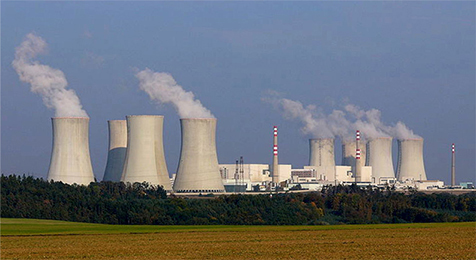| << Chapter < Page | Chapter >> Page > |

Heat engines operate by carrying a working substance through a cycle. In a steam power plant, the working substance is water, which starts as a liquid, becomes vaporized, is then used to drive a turbine, and is finally condensed back into the liquid state. As is the case for all working substances in cyclic processes, once the water returns to its initial state, it repeats the same sequence.
For now, we assume that the cycles of heat engines are reversible, so there is no energy loss to friction or other irreversible effects. Suppose that the engine of [link] goes through one complete cycle and that and W represent the heats exchanged and the work done for that cycle. Since the initial and final states of the system are the same, for the cycle. We therefore have from the first law of thermodynamics,
so that
The most important measure of a heat engine is its efficiency ( e ) , which is simply “what we get out” divided by “what we put in” during each cycle, as defined by
With a heat engine working between two heat reservoirs, we get out W and put in so the efficiency of the engine is
Here, we used [link] , in the final step of this expression for the efficiency.
Explain in practical terms why efficiency is defined as
An engine is found to have an efficiency of 0.40. If it does 200 J of work per cycle, what are the corresponding quantities of heat absorbed and rejected?
In performing 100.0 J of work, an engine rejects 50.0 J of heat. What is the efficiency of the engine?
0.667
An engine with an efficiency of 0.30 absorbs 500 J of heat per cycle. (a) How much work does it perform per cycle? (b) How much heat does it reject per cycle?
It is found that an engine rejects 100.0 J while absorbing 125.0 J each cycle of operation. (a) What is the efficiency of the engine? (b) How much work does it perform per cycle?
a. 0.556; b. 125.0 J
The temperature of the cold reservoir of the engine is 300 K. It has an efficiency of 0.30 and absorbs 500 J of heat per cycle. (a) How much work does it perform per cycle? (b) How much heat does it reject per cycle?
The Kelvin temperature of the hot reservoir of an engine is twice that of the cold reservoir, and work done by the engine per cycle is 50 J. Calculate (a) the efficiency of the engine, (b) the heat absorbed per cycle, and (c) the heat rejected per cycle.
a. 0.50; b. 100 J; c. 50 J
A coal power plant consumes 100,000 kg of coal per hour and produces 500 MW of power. If the heat of combustion of coal is 30 MJ/kg, what is the efficiency of the power plant?

Notification Switch
Would you like to follow the 'University physics volume 2' conversation and receive update notifications?